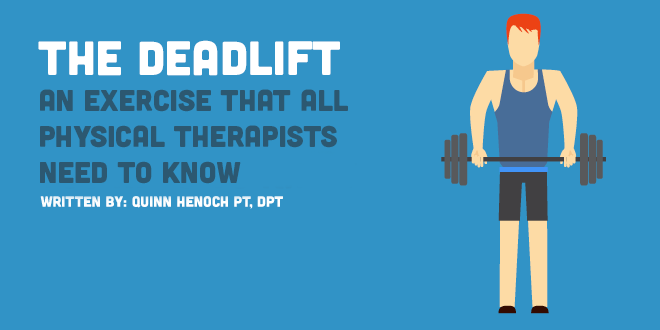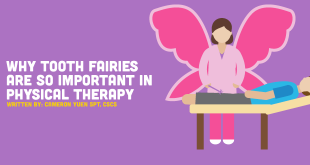As a physical therapist, you will often be teaching your patients the safest way to pick objects up from the ground. This is a vital skill to possess as a practitioner. It is important not only to keep your patients safe in the clinic, but also to progress their strengthening program appropriately. The deadlift is a fantastic way to empower your patients and decrease the fear avoidance that often accompanies cases of low back pain. Picking up heavy things is a common activity of daily living. They are going to do it anyway, so you might as well show them how.
Likewise, if you treat athletes, it is very possible that they will be deadlifting as part of their strength and conditioning program. Having an understanding of proper mechanics as it relates to the deadlift as a performance tool will create buy-in from your athlete, as they will see that you speak their language.
**Disclaimer**
I am not addressing interventions for pain in this article. If something hurts during a screen or assessment, and you are not a licensed health care provided, refer to a PT near you.
Screening & Assessment
The assessment for the deadlift can be very simple. We want to know if the joint can get into the positions that they will be loaded in, without pain or apprehension. After this, it simply comes down to coaching the athlete to put his or her body in the appropriate position/s.
Lumbar Screening
A forward toe touch test will show us if the athlete can tolerate forces through the lumbar spine. Of course, we are not going to load the deadlift with a rounded back, but this screen gives us an idea of whether they can tolerate the forward bending required, and can assist in ruling out potential pathology.
Instructions:
- Stand with feet hip width apart.
- Bend forward and reach for your toes, allowing the lower back to round comfortably.
- You can add over pressure to make the test more sensitive.
What to look for:
- Pain or apprehension
- Athlete can reach the last 1/3 of the tibia, at least.
- If they have less range of motion than this we may modify the height at which the deadlift is performed.
It is also important to screen lumbar extension, since global extension is the movement strategy the athlete will use in the deadlift pattern.
Instructions:
- Reach overhead, performing a back bend (“limbo-style”).
- Bend back as far as you can comfortably.
After, have the athlete place their hands on their hips and perform the same test, increasing sensitivity to the lower lumbar.
What we are looking for:
- Pain or apprehension with lumbar extension
- This does not preclude the athlete from deadlifting, but will be important that proper lockout of the hips be demonstrated at the top of the lift, as opposed to hyperextending through the spine.
Leg Raise (single leg hinging)
After the spine is screened, we want to screen the hips for adequate posterior chain extensibility, both actively & passively.
It is important that the athlete can demonstrate the ability to horizontally hinge at the hips to approximately 70 degrees. Based on clinical experience, this is adequate mobility to perform a proper hip hinge pattern. Again, the execution of the pattern will come down to appropriate cueing.
Thomas Test
Active hip extension is necessary to fully lock out the deadlift during the last portion of the lift. We can screen passive hip extension capacity, then base interventions on the result. We are looking for the hip to drop to parallel.
Passive hip extension capacity, and the ability to actively control it, will be vital for athletes who are sensitive to lumbar extension.
The Hip Hinge
As mentioned previously, I typically do not include the hip hinge as part of my screen, because I find that I end up spending time coaching instead of assessing. I save it for when I actually plan to coach. However, if an athlete has adequate hip hinge range of motion, without pain or apprehension, then that can act as your entire screen. At that point, a proper bracing sequence and appropriate loading are the next steps. For the hip hinge screen, we are looking for the athlete to be able to reach the wrists to approximately the level of the tibial tubercle.
Here is a very easy way to coach the hip hinge.
https://www.youtube.com/watch?v=TwEJ7e_pm7o
Assessment Summary
As clinicians, we can sometimes get caught up in the “stretch what’s tight” mindset. While sometimes this is the appropriate course of action, it is recommended that you consider the role the nervous system can have on perceived tightness. In regards to the deadlift, the hamstrings can be a scapegoat as being deemed “tight” without considering the nervous system. Here are two videos discussing this concept.
Movement Prep For The Deadlift
We love to use variations of the developmental positions (supine, sidelying, quadruped, half kneeling, and tall kneeling) to teach proper positioning because it creates a stable environment where motor learning can occur. We then “build the athlete up” to standing, and progress the deadlift pattern from there.
Breathing & Bracing
Creating adequate intra-abdominal pressure is important during the deadlift in order to maintain a neutral pelvis and spinal position. It will then be important that the athlete use this breathing and bracing sequence as we build movement patterns. Here are 3 drills that can aid in teaching the correct pattern.
This drill will assist in correcting the straight leg raise (single leg hinging) control.
This drill below will teach the athlete how to fight hyperextension of the lumbar spine. This is a form of Reactive Neuromuscular Training (RNT) in which the band is pulling the athlete into a fault (lumbar hyperextension), so that the athlete must reflexively correct. **I’m holding the band with my hands, not around my neck.
Hip Extension
A mix of glute bridges and kneeling positions are great starting points to improve hip extension capacity and control. Use these if the athlete exhibited a positive Thomas Test and/or to teach them to actively extend the hip without hyperextending the lumbar spine.
(drill starts at 4:30 mark)
Progressing The Deadlift
We can now load the deadlift in standing. Be sure to use appropriate progressions that meet the athlete “where they are” in terms of mobility and stability.
A kettlebell deadlift is a great place to start teaching this lift because the weight can be directly under the athlete, and allows for better balance. The weight can be raised on a block to further decrease range of motion and error, per clinician discretion.
The single leg deadlift is a great way to correct side-to-side imbalances. You should be very strict with technique. Make the patient “own” each side. Here is my favorite way to coach and progress this movement.
At this point, we are moving to variations that may be more suited for the strength and conditioning setting. However, it’s important that you are familiar with them so that you can discuss them with the patient and coach.
The Trap Bar Deadlift is a great tool to add significant load to the pattern, but allow the athlete to sit into a more comfortable pulling position than with a straight barbell. This is because the bar does not have to be pulled around the knees, and the lifter can simply hinge straight down, and pull straight up.
When progressing to a straight bar, the rack pull above the knee is a great starting point. The athlete can really focus on dialing in the hinging pattern, along with the breathing and bracing sequence. As the athlete becomes confident and the clinician deems the technique safe, the bar can be lowered to the floor progressively.
Finally, we introduce pulling a straight bar from the floor.
Conclusion
This is certainly not a comprehensive manual on deadlift training or how to assess and correct the pattern, but it should give you the basic tools to use in this exercise in the clinic the next time you have a patient who needs to lift something up (almost every orthopedic patient ever?).
 NewGradPhysicalTherapy.com The Largest Online Resource For New Grad Physical Therapists
NewGradPhysicalTherapy.com The Largest Online Resource For New Grad Physical Therapists






